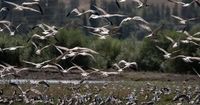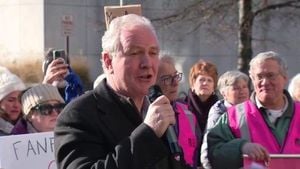Across the United States, a silent but significant shift is taking place in the skies. Birds, long known for their reliable migration patterns, are now behaving in ways that have left scientists deeply unsettled. This change, researchers warn, could have dire consequences not just for birds themselves, but for humanity and the natural balance we depend on.
On October 7, 2025, researchers and ornithologists sounded the alarm: birds throughout the US are abandoning their usual migration routines. The culprit? Warmer temperatures in their winter habitats, which are throwing off the environmental cues birds have relied on for generations to time their annual journeys. According to Andrew Farnsworth, a migration ecologist at Cornell University, this disruption is more than just a curiosity—it could spell disaster for many bird species and the ecosystems they support.
"There's this very close relationship between where birds are when on the planet and what's happening with the climate and what's happening with weather," Farnsworth told NBC Connecticut. His warning is echoed by conservationists and scientists nationwide, who have tracked a cascade of troubling effects stemming from these altered migration patterns.
Birds are not just beautiful additions to our landscapes; they play a crucial role in the natural world. They control pests, spread seeds, and pollinate plants. In fact, about five percent of the plants humans use for food and medicine rely on birds for pollination. If these avian populations continue to shrink, the ripple effects could be profound. Food production could falter, medicinal plants may become scarce, and the intricate web of life could unravel in ways that are difficult to predict.
The National Audubon Society, a leading nonprofit dedicated to protecting birds and their habitats, has issued a stark warning: 389 North American bird species—nearly two-thirds of those studied—will become vulnerable to extinction within the next 50 years. Researchers estimate that these birds risk losing more than half of their habitats by 2080, a loss driven primarily by climate change, habitat destruction, pesticides, and urban development.
The numbers paint a grim picture. A study by the Cornell Lab of Ornithology revealed that approximately three billion birds in North America have vanished since 1970. That’s not a typo—three billion, gone. When birds die off en masse, the effects are immediate and far-reaching. The pollination of tropical plants like bananas, coffee, and cacao—key ingredients for daily staples and treats—suffers. Medicinal plants, including orchids and aloe species used in traditional and modern remedies, may also decline, limiting access to vital natural treatments.
Why are birds struggling so much? Rising global temperatures have changed the timing of the seasons, especially in the Arctic and northern forests. Birds in warming regions are now leaving their nests either earlier or later than usual, often arriving at breeding or feeding grounds before essential food sources like insects or plants are available. This mismatch can be fatal. Birds may starve, fail to find suitable shelter, or struggle to locate mates, leading to smaller populations as fewer survive the winter.
Several species in the US have already been hit hard. The Black-throated Blue Warbler, for example, has seen its numbers drop due to climate-driven mismatches. These birds migrate from North America to the Caribbean, but changes in timing mean they often arrive when food is scarce. According to Audubon researchers, "Black-throated Blue Warblers have seen their populations drop off in the US due to climate-driven mismatches that have left the birds with less food when they migrate."
Another victim is the Red Knot, a shorebird that undertakes an epic journey from the Arctic to South America. Their populations have declined by around 75 percent. The Cornell Lab found that warming Arctic temperatures have disrupted their breeding grounds, while rising sea levels have shrunk their coastal feeding sites. The result? Fewer Red Knots make the journey each year, threatening the species’ survival.
Swainson's Thrush, which migrates from Canada and Alaska to Central and South America, is also struggling. Wildfires and warming forests have destroyed vital nesting and stopover sites in states like California, Oregon, Washington, New York, Maine, and Colorado. Without these critical habitats, Swainson's Thrush populations are dwindling.
Farnsworth emphasized the severity of the situation, stating, "We do see birds track climate change, obviously some are managing to do it, but the challenge is for those that can't." In other words, while a handful of adaptable species might keep pace with the changing climate, many others are left behind, unable to adjust quickly enough to survive.
The consequences of these changes are not limited to birds alone. When birds disappear, the plants they pollinate and the pests they control can surge unchecked, potentially disrupting agriculture and natural ecosystems. Farmers may face new challenges growing enough food, which could drive up costs and affect food availability worldwide.
Human activities are making matters worse. Habitat loss from urban development, pesticide use, and even seemingly innocent actions like feeding birds can exacerbate the crisis. Researchers have noted that people who feed birds may unintentionally discourage migration and attract predators, further endangering already vulnerable species.
The National Audubon Society’s warning that 389 North American bird species could be at risk of extinction within 50 years is not just a statistic—it’s a call to action. These birds represent nearly two-thirds of the species studied, underscoring the scale of the threat. If current trends continue, researchers warn, we could witness a mass extinction event with consequences for biodiversity, food security, and human well-being.
The main drivers behind this looming crisis are clear: habitat loss, climate change, pesticides, and collisions with buildings and windows. Each of these factors alone would be concerning; together, they form a perfect storm that threatens to reshape the natural world as we know it.
Some might wonder if there’s any hope left. Farnsworth and others believe that while some birds are managing to adapt to the changing climate, the real challenge lies in helping those that cannot. Conservation efforts, habitat restoration, and changes in human behavior could help tip the scales in favor of survival. But the clock is ticking.
As birds across the US and beyond face unprecedented challenges, their fate serves as a stark reminder of the interconnectedness of all life. The choices made today will determine whether future generations inherit a world filled with birdsong—or one marked by silence.




